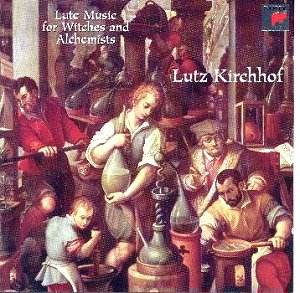Lute Music for Witches and
Alchemists
 Lutz Kirchhof (Renaissance,
Lute, Vihuela, Baroque Lute and
Theorbolute)
Lutz Kirchhof (Renaissance,
Lute, Vihuela, Baroque Lute and
Theorbolute)
 SONY SK 60767 [72:42]
SONY SK 60767 [72:42]

Here is an oddity. Lutz Kirchhof, performing on four types of lute for this
album, writes in his eye-opening, if not jaw-dropping notes that one of the
techniques of witchcraft involved using music and dance in order to stimulate
the life forces in the atmosphere. Likening the ultimate tragic abandonment
of the instrument to lost Atlantis, he asserts that the lute - though it
had been the most important instrument in Europe for many centuries - sank
into oblivion at the onset of more modern instruments. He reminds of its
former ubiquitous use "on the streets, at court, while travelling, in chambers,
inns, and at the barber's, at feasts, in the bath, in the open air, at lovers'
trysts, in the alchemists laboratory…lute music was heard everywhere."
He quotes a 17th century authority, Pater Mersenne, in Harmonie
Universelle, as saying, "A lutenist can accomplish everything with his
instrument. He holds sway, for example, over the geometric means to square
the circle, establish the relationships of the stars to one another and determine
the velocity of falling bodies - all these he can do and a thousand other
things besides." Fanciful, well yes in the literal sense, yet Kirchhof poses
some interesting metaphysical speculations.
Between the cue titles at the front of the book Kirchhof tells us that 'Witches
and wise women used dance music for secret celebrations and healings' [He
uses the appellation 'witches' in its original terminology for "women who
possessed wisdom and were versed in both medicinal and herbal arts"]. He
then tells us that "Alchemists were prone to bouts of melancholy on account
of their lonely occupation - music [was used] 'for the recreation of the
spirit'". One of the numbers, 'Chorea 1', apparently, was "a little dance
which those sick from the bite of a tarantula or spider especially like to
hear!" and the Tarantella was "a musical remedy against the venom of the
tarantula."
Kirchhof also tells us that the four elements exist on a material level and
a mental level; their effects are reflected in music and he plays pieces
that are attuned to Air, Water, Earth and Fire.
Whether you regard all this as fanciful or not this is a relaxing concert
of 30 numbers, from the 16th and 17th centuries by
such composers as Anthony Holborne, Johann Daniel Mylius, and François
Dufaut, for the four different types of lute. The pieces are in many styles
and moods and in not a few cases, one has the eerie feeling that later forms
are being anticipated. The music is beautifully played and one can enjoy
all the little felicities and nuances of this most convivial of instruments.
The notes warn that "In order not to distort the naturally delicate character
of the lute tone, the listening volume should not be set too high."
A charming oddity
Reviewer
Ian Lace


![]()